Android Recovery 模式
(muddogxp 原创,转载请注明)
http://blogold.chinaunix.net/u/14459/showart_1911144.html
Recovery简介
Android 利用 Recovery 模式,进行恢复出厂设置,OTA 升级,patch 升级及
firmware 升级。
升级一般通过运行升级包中的 META-INF/com/google/android/update-script
脚本来执行自定义升级,脚本中是一组 recovery 系统能识别的 UI 控制,文件
系统操作命令,例如 write_raw_image(写 FLASH 分区),copy_dir(复制目
录)。该包一般被下载至 SDCARD 和 CACHE 分区下。如果对该包内容感兴趣,可
以从 http://forum.xda-developers.com/showthread.php?t=442480 下载 JF 升
级包来看看。
升级中还涉及到包的数字签名,签名方式和普通 JAR 文件签名差不错。公钥会
被硬编译入 recovery,编译时生成在:
out/target/product/XX/obj/PACKAGING/ota_keys_inc_intermediates/keys.
inc
G1中的三种启动模式
MAGIC KEY:
• camera + power:bootloader 模式,ADP 里则可以使用 fastboot 模式
• home + power:recovery 模式
• 正常启动
Bootloader 正常启动,又有三种方式,按照 BCB(Bootloader Control
Block, 下节介绍)中的 command 分类:
• command == 'boot-recovery' → 启动 recovery.img。recovery 模式
• command == 'update-radio/hboot' → 更新 firmware(bootloader)
•
其他 启动 boot.img
→
Recovery涉及到的其他系统及文件
• CACHE 分区文件
Recovery 工具通过 NAND cache 分区上的三个文件和主系统打交道。主系
统(包括恢复出厂设置和 OTA 升级)可以写入 recovery 所需的命令,读
出 recovery 过程中的 LOG 和 intent。
�
• /cache/recovery/command: recovery 命令,由主系统写入。所有命
令如下:
• --send_intent=anystring - write the text out to recovery.intent
• --update_package=root:path - verify install an OTA package file
• --wipe_data - erase user data (and cache), then reboot
• --wipe_cache - wipe cache (but not user data), then reboot
• /cache/recovery/log:recovery 过程日志,由主系统读出
• /cache/recovery/intent:recovery 输出的 intent
• MISC 分区内容
Bootloader Control Block (BCB) 存放 recovery bootloader message。结构如
下:
struct bootloader_message {
char command[32];
char status[32]; // 未知用途
char recovery[1024];
};
• command 可以有以下两个值
“boot-recovery”:标示 recovery 正在进行,或指示 bootloader 应该进
入 recovery mode
“update-hboot/radio”:指示 bootloader 更新 firmware
• recovery 内容
“recovery\n
\n
”
其中 recovery command 为 CACHE:/recovery/command 命令
两种Recovery Case
• FACTORY RESET(恢复出厂设置)
“
”
用户选择 恢复出厂设置
1.
2. 设置系统将"--wipe_data"命令写入/cache/recovery/command
3. 系统重启,并进入 recover 模式(/sbin/recovery)
4. get_args() 将 "boot-recovery"和"--wipe_data"写入 BCB
5. erase_root() 格式化(擦除)DATA 分区
6. erase_root() 格式化(擦除)CACHE 分区
7. finish_recovery() 擦除 BCB
8. 重启系统
�
• OTA INSTALL(OTA 升级)
1. 升级系统下载 OTA 包到/cache/some-filename.zip
2. 升级系统写入 recovery 命令"--update_package=CACHE:some-filename.zip"
3. 重启,并进入 recovery 模式
4. get_args() 将"boot-recovery" 和 "--update_package=..." 写入 BCB
5. install_package() 作升级
6. finish_recovery() 擦除 BCB
7. ** 如果安装包失败 ** prompt_and_wait() 等待用户操作,选择 ALT+S 或
ALT+W 升级或恢复出厂设置
8. main() 调用 maybe_install_firmware_update()
1. 如果包里有 hboot/radio 的 firmware 则继续,否则返回
2. 将 "boot-recovery" 和 "--wipe_cache" 写入 BCB
3. 将 firmware image 写入 cache 分区
4. 将 "update-radio/hboot" 和 "--wipe_cache" 写入 BCB
5. 重启系统
6. bootloader 自身更新 firmware
7. bootloader 将 "boot-recovery" 写入 BCB
8. erase_root() 擦除 CACHE 分区
9. 清除 BCB
9. main() 调用 reboot() 重启系统
Recovery模式流程
/init → init.rc → /sbin/recovery →
main():recovery.c
• ui_init():ui.c [UI initialize]
• gr_init():minui/graphics.c [set tty0 to graphic mode,
open fb0]
• ev_init():minui/events.c [open /dev/input/event*]
• res_create_surface:minui/resource.c [create surfaces for
all bitmaps used later, include icons, bmps]
• create 2 threads: progress/input_thread [create progress
show and input event handler thread]
• get_args():recovery.c
• get_bootloader_message():bootloader.c [read mtdblock0(misc
partition) 2nd page for commandline]
• check if nand misc partition has boot message. If yes,
fill argc/argv.
�
• If no, get arguments from /cache/recovery/command, and
fill argc/argv.
• set_bootloader_message():bootloader.c [set bootloader
message back to mtdblock0]
• Parser argv[] filled above
• register_update_commands():commands.c [ register all commands
with name and hook function ]
• registerCommand():commands.c
• Register command with name, hook, type, cookie.
• Commands, e.g: assert, delete, copy_dir, symlink,
write_raw_image.
• registerFunction():commands.c
• Register function with name, hook, cookie.
• Function, e.g: get_mark, matches, getprop,
file_contains
• install_package():
• translate_root_path():roots.c [ "SYSTEM:lib" and turns it
into a string like "/system/lib", translate the
updater.zip path ]
• mzOpenZipArchive():zip.c [ open updater.zip file
(uncompass) ]
• handle_update_package():install.c
• verify_jar_signature():verifier.c [ verify signature
with keys.inc key; verify manifest and zip package
archive ]
• verifySignature() [ verify the signature file:
CERT.sf/rsa. ]
• digestEntry():verifier.c [ get SHA-1 digest
of CERT.sf file ]
• RSA_verify(public key:keys.inc,
signature:CERT.rsa, CERT.sf's
digest):libc/rsa.c [ Verify a 2048 bit RSA
PKCS1.5 signature against an expected SHA-1
hash. Use public key to decrypt the
CERT.rsa to get original SHA digest, then
compare to digest of CERT.sf ]
�
• verifyManifest() [ Get manifest SHA1-Digest from
CERT.sf. Then do digest to MANIFEST.MF. Compare
them ]
• verifyArchive() [ verify all the files in
update.zip with digest listed in MANIFEST.MF ]
• find_update_script():install.c [ find META-
INF/com/google/android/update-script updater script ]
• handle_update_script():install.c [ read cmds from
script file, and do parser, exec ]
• parseAmendScript():amend.c [ call yyparse() to
parse to command ]
• exeCommandList():install.c
• exeCommand():execute.c [ call command hook
function ]
• erase DATA/CACHE partition
• prompt_and_wait():recovery.c [ wait for user input: 1) reboot
2) update.zip 3) wipe data ]
• ui_key_xxx get ALT+x keys
• 1) do nothing
• 2) install_package('SDCARD:update.zip')
• 3) erase_root() → format_root_device() DATA/CACHE
• may_install_firmware_update():firmware.c
[ remember_firmware_update() is called by
write_hboot/radio_image command, it stores the bootloader image
to CACHE partition, and write update-hboot/radio command to
MISC partition for bootloader message to let bootloader update
itself after reboot ]
• set_bootloader_message()
• write_update_for_bootloader():bootloader.c [ write
firmware image into CACHE partition with update_header,
busyimage and failimage ]
• finish_recovery():recovery.c [ clear the recovery command and
prepare to boot a (hopefully working) system, copy our log file
to cache as well (for the system to read), and record any
intent we were asked to communicate back to the system. ]
• reboot()
�
Recovery 模式流程图
以下流程图绘制了系统从启动加载 bootloader 后的行为流程。
�
�
�
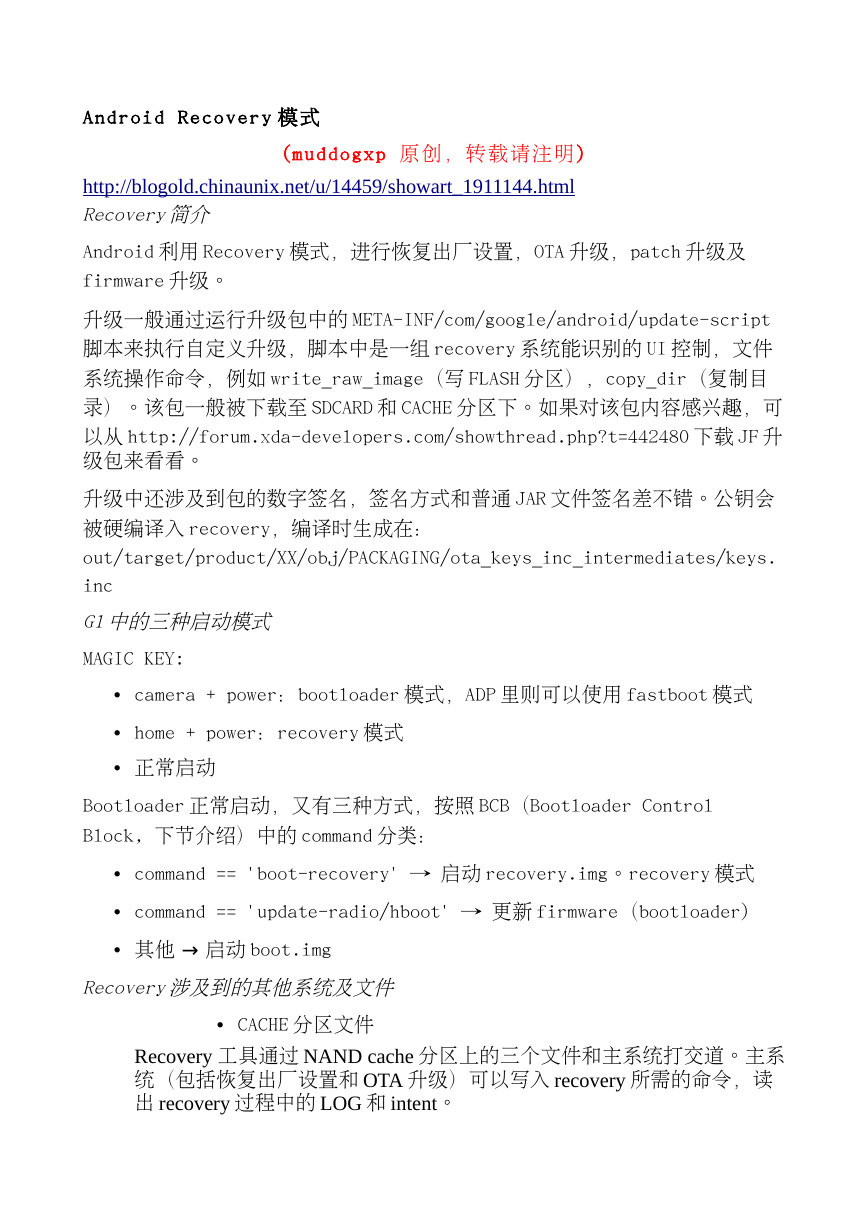
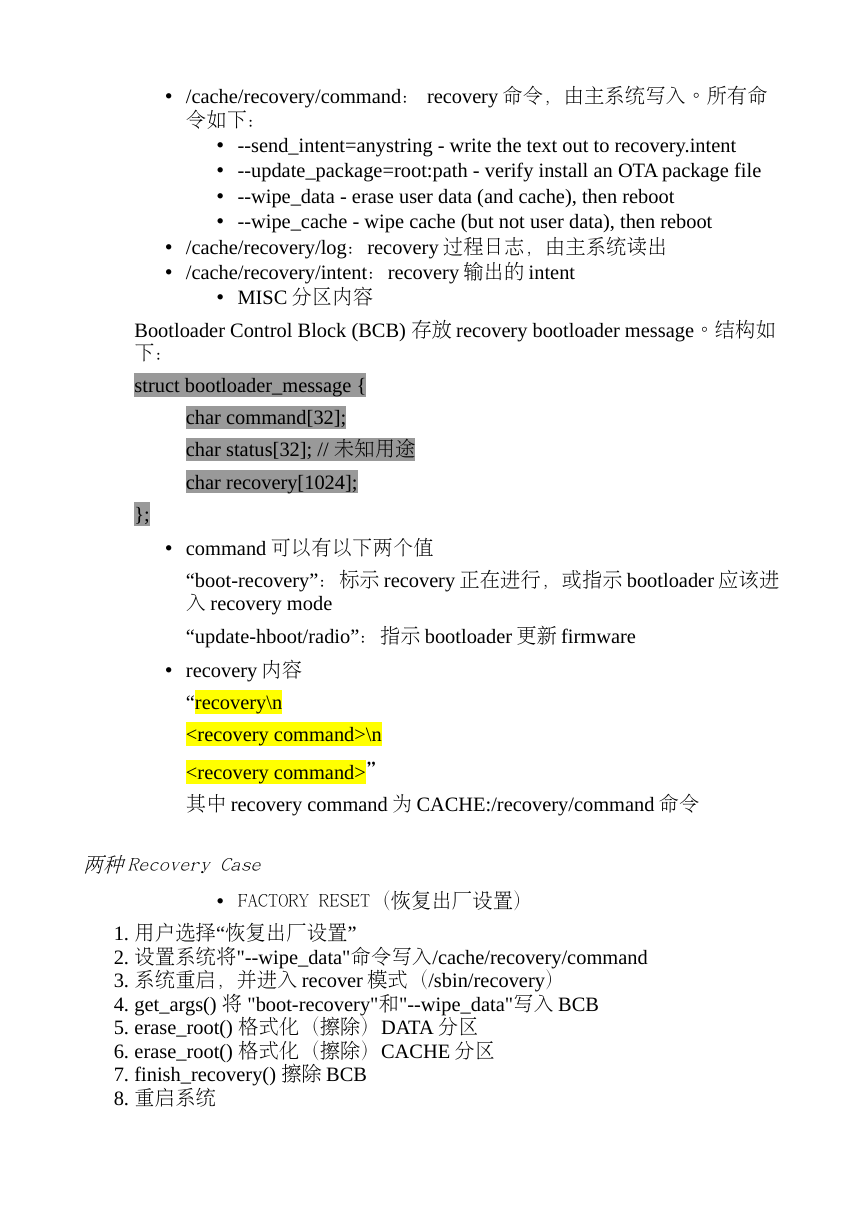
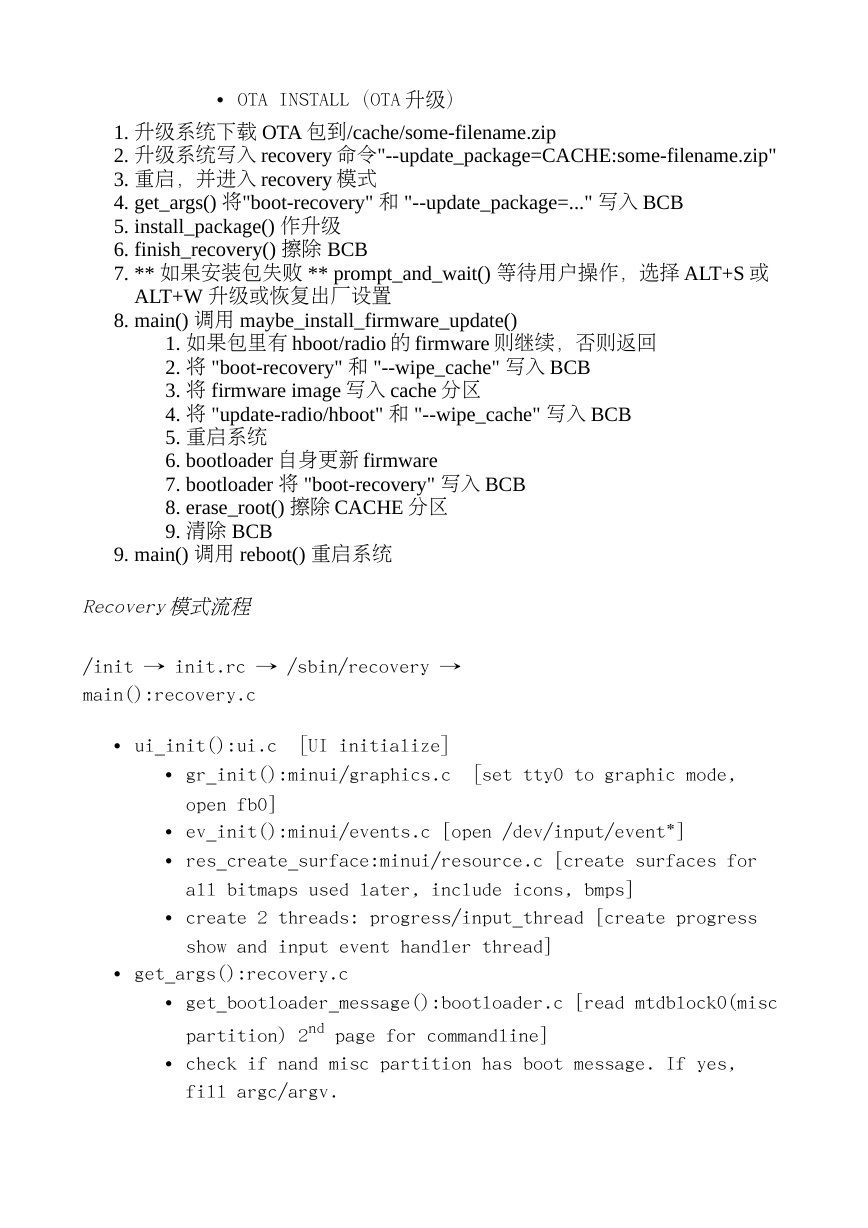
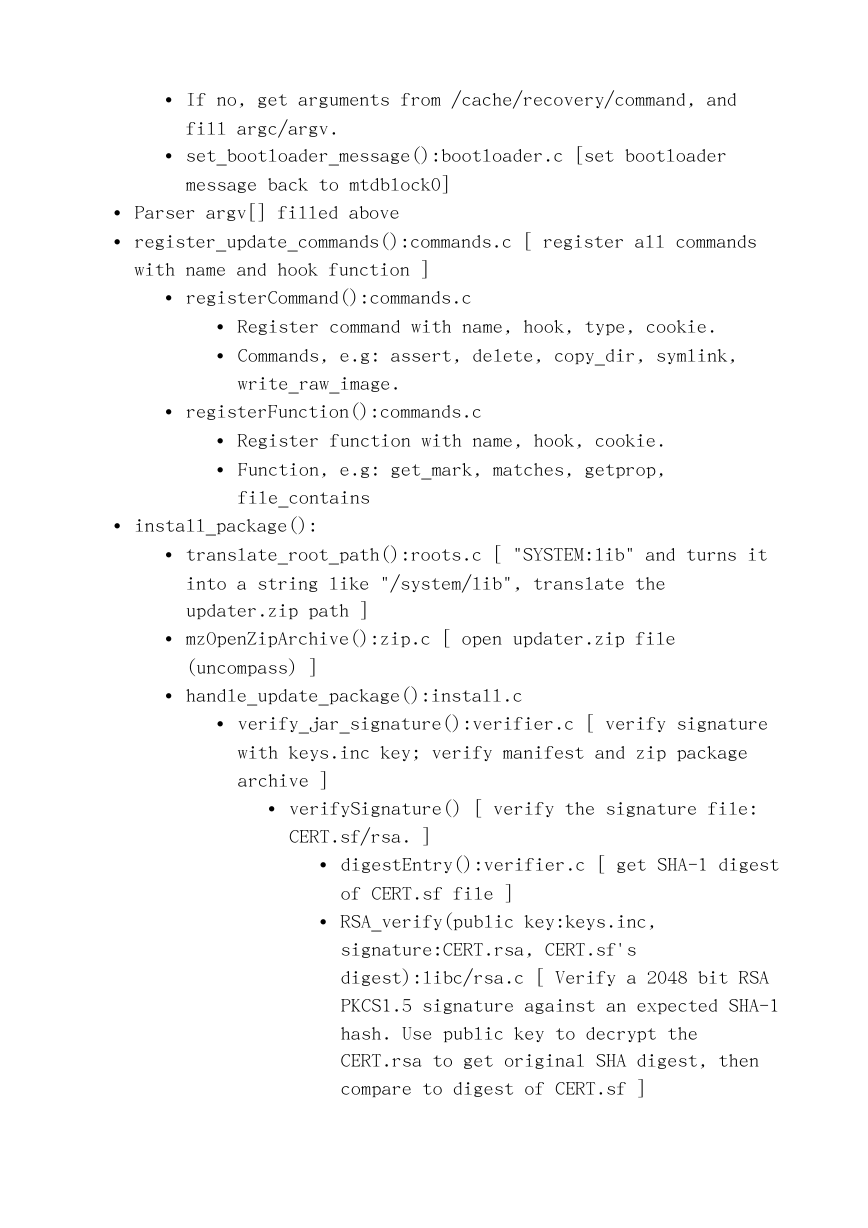
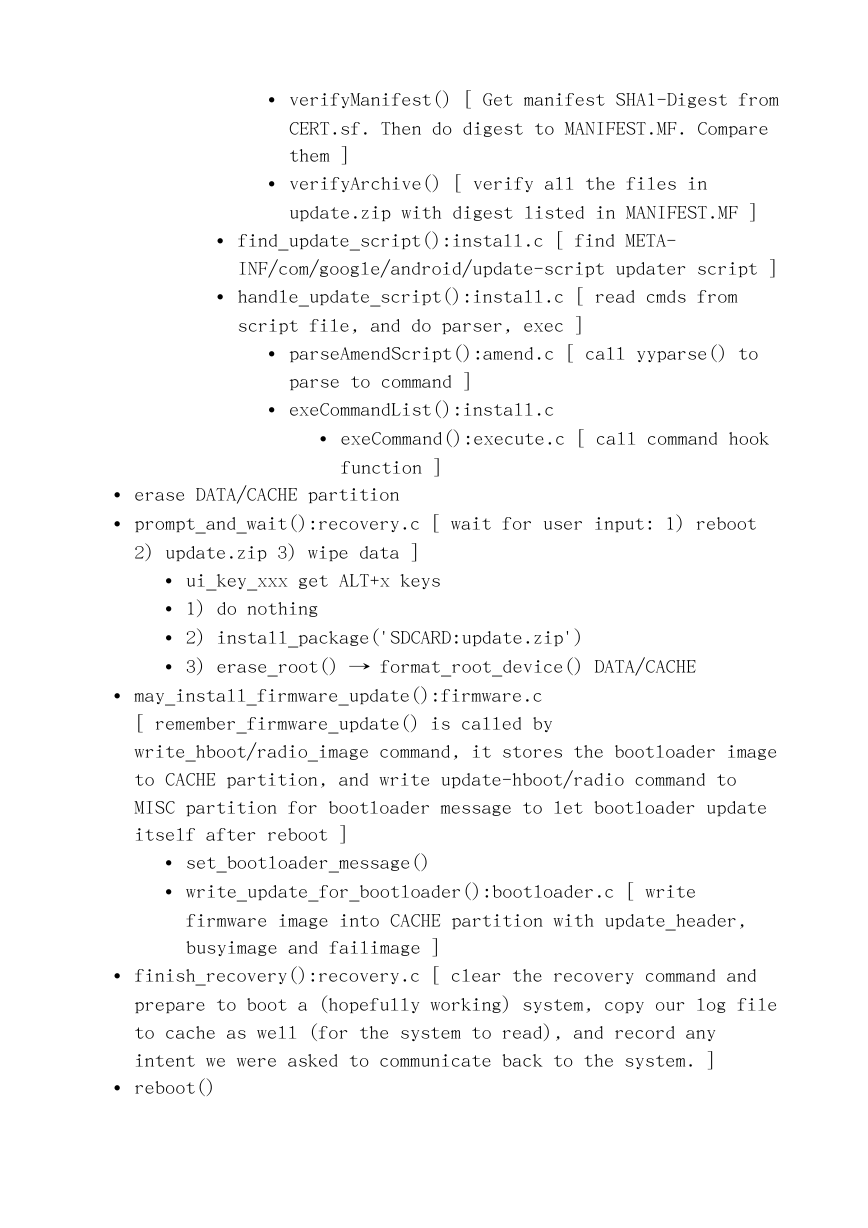


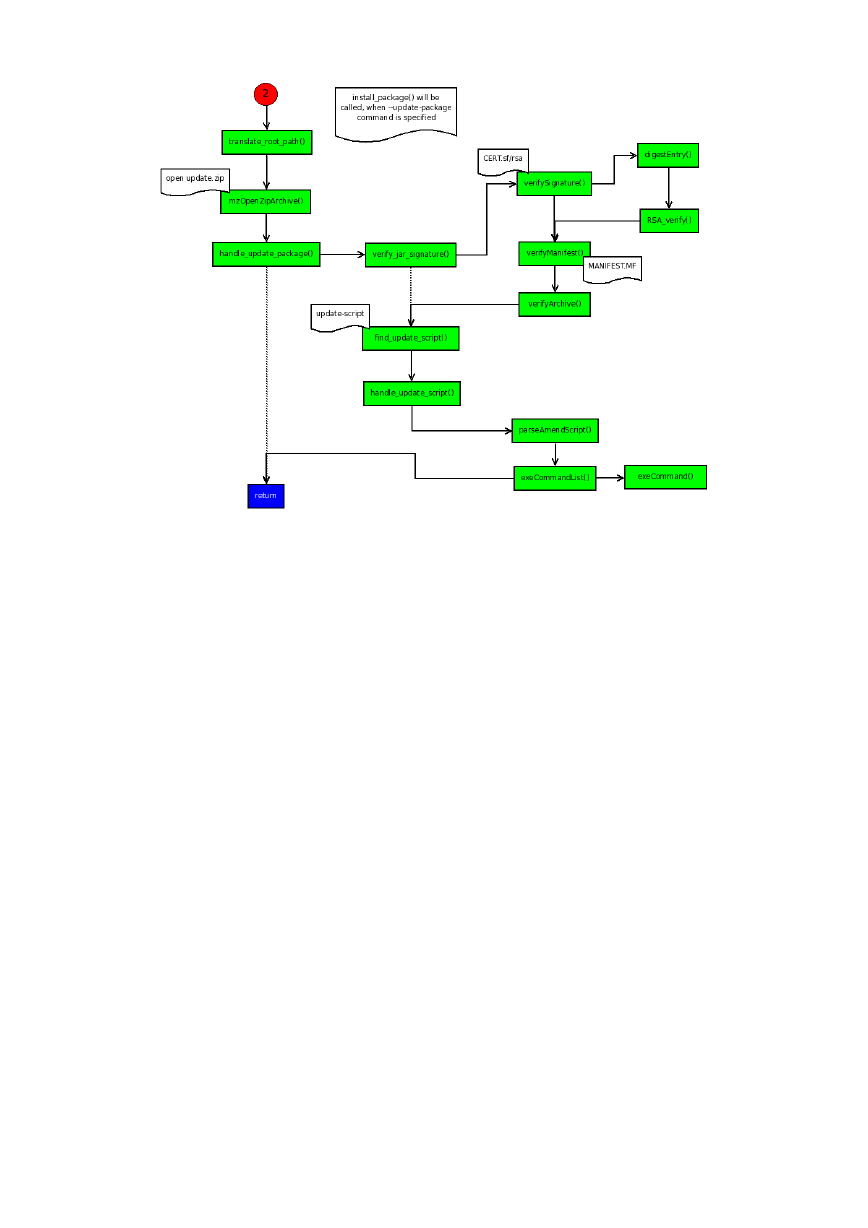








 2023年江西萍乡中考道德与法治真题及答案.doc
2023年江西萍乡中考道德与法治真题及答案.doc 2012年重庆南川中考生物真题及答案.doc
2012年重庆南川中考生物真题及答案.doc 2013年江西师范大学地理学综合及文艺理论基础考研真题.doc
2013年江西师范大学地理学综合及文艺理论基础考研真题.doc 2020年四川甘孜小升初语文真题及答案I卷.doc
2020年四川甘孜小升初语文真题及答案I卷.doc 2020年注册岩土工程师专业基础考试真题及答案.doc
2020年注册岩土工程师专业基础考试真题及答案.doc 2023-2024学年福建省厦门市九年级上学期数学月考试题及答案.doc
2023-2024学年福建省厦门市九年级上学期数学月考试题及答案.doc 2021-2022学年辽宁省沈阳市大东区九年级上学期语文期末试题及答案.doc
2021-2022学年辽宁省沈阳市大东区九年级上学期语文期末试题及答案.doc 2022-2023学年北京东城区初三第一学期物理期末试卷及答案.doc
2022-2023学年北京东城区初三第一学期物理期末试卷及答案.doc 2018上半年江西教师资格初中地理学科知识与教学能力真题及答案.doc
2018上半年江西教师资格初中地理学科知识与教学能力真题及答案.doc 2012年河北国家公务员申论考试真题及答案-省级.doc
2012年河北国家公务员申论考试真题及答案-省级.doc 2020-2021学年江苏省扬州市江都区邵樊片九年级上学期数学第一次质量检测试题及答案.doc
2020-2021学年江苏省扬州市江都区邵樊片九年级上学期数学第一次质量检测试题及答案.doc 2022下半年黑龙江教师资格证中学综合素质真题及答案.doc
2022下半年黑龙江教师资格证中学综合素质真题及答案.doc